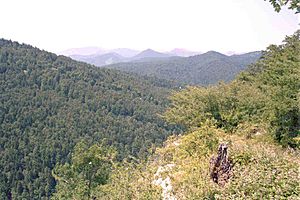Irati Forest facts for kids
The Irati Forest is a huge and beautiful forest located in the western Pyrenees mountains. It covers about 17,300 hectares (that's like 173 square kilometers!) across parts of France and Spain. This amazing forest is found in the Navarre region of Spain, and in the Soule and Basse-Navarre provinces of France.
It sits between two mountains: Mount Okabe (1,466 meters tall) and Pic d'Orhy (2,017 meters tall). The Irati Forest is super special because it's the second largest and best-kept mixed forest of beech and fir trees in all of Europe!
Contents
Discovering the Irati Forest
This forest feels wild and mysterious. That's because not many people live nearby. Many local legends and stories have been told about this magical place.
For a long time, it was hard to get into the forest. The main road that lets people access it was only built in 1964.
What's in a Name?
The name "Irati Forest" comes from the Irati river. This river starts where two smaller rivers, the Urtxuria and Urbeltza, meet.
Animals of the Irati Forest
The Irati Forest is home to many animals that live in the Pyrenees mountains. You might spot many different birds flying around.
- Birds: Look for tiny goldcrests, cheerful chaffinches, bright red-breasted robins, and two types of woodpeckers: the black woodpecker and the white-backed woodpecker.
- Larger Mammals: Some bigger animals that live here include clever foxes, strong wild boar, quick martens, and graceful roe deer.
- Smaller Mammals: If you look closely, you might see small creatures like the red vole, the gray dormouse, and the tiny shrew. Other interesting animals are the polecat and the badger.
Plants of the Irati Forest
The main trees you'll see in the Irati Forest are tall beech trees and slender silver fir trees. But there are many other types of plants too!
- Other Trees: The forest also has linden, hazelnut, elm, willow, maple, boxwood, and juniper trees. Very rarely, you might even find a yew tree.
- Other Plants: The ground is covered with ferns, lichens, and soft moss. You can also find sloe bushes. Some rare flowering plants like narcissus and winter bell grow here too. Even though they used to be more common, you can still find some single oak trees.
Even though people have used parts of the forest for wood over time, it's still a very healthy and diverse place. It has many different environments, including thick forests, wet areas, mountain meadows, and rocky spots. You can also find areas with Atlantic heaths, which are like open fields with plants such as blueberry and different types of gorse.
Gallery
See also
 In Spanish: Selva de Irati para niños
In Spanish: Selva de Irati para niños





